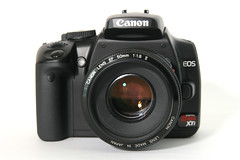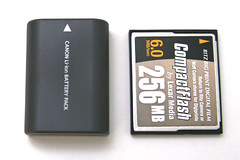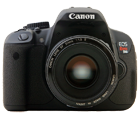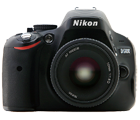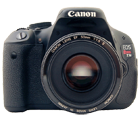Canon Rebel xTi 400D Guide
|
This Canon EOS Rebel xTi guide will introduce you to this extremely popular 10 megapixel digital SLR. Just how popular is it? The Rebel xTi has been the top-selling digital SLR camera every month since its release (per the list of Top-Selling Digital SLR Cameras at PopPhoto.com). The xTi — also called the 400D — is the successor to the (previously) top-selling Canon Rebel XT (350D), and it builds upon the features of that camera in several key ways. The most notable improvements over the Rebel XT include:
Another key selling point is the camera's compact size and reduced weight. Since it doesn't weigh a ton, you're much more likely to carry it around so you don't miss a fleeting photographic moment. A less obvious feature is how well this camera handles images at high ISO settings. If you're not sure what ISO is all about, don't worry - we'll tackle that in depth later on this this Rebel xTi Guide. |
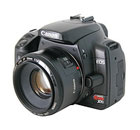 |
Quick Overview
- 10.1 megapixel sensor - for high-quality 16x20 inch prints
- Compatible with all EOS lenses
- 3 photos per second
- ISO settings from 100 to 1600
- Maximum shutter speed of 1/4000th of a second
- 1.6 times crop factor
- 2.5" LCD
- Stores photos on Compact Flash memory cards
- 9-area autofocus system
Key Feature
With the Rebel xTi, Canon has officially recognized of the big problems facing digital SLR cameras: sensor dust.
The original dust-repellent sensor was created by Olympus, and is standard on all Olympus digital SLR cameras.
The Canon Rebel xTi includes 3 separate features designed to prevent and eliminate dust:
- The low pass filter (located directly in front of the sensor) is electrostatically charged to fend off charged dust particles
- Any dust that attaches itself to the filter is shaken loose, since the filter vibrates ultrasonically (like the filters on the Olympus cameras)
- A final solution for persitent dust that attaches itself to the sensor is the ability to "map" the dust spots - this can be used in conjunction with Canon software to automatically remove dust from all of your digital photos
What does all of this dust-repellent technology mean for you?
Clearer digital photos taken with your SLR, and less of a chance that you'll have to send it in for professional cleaning.
Canon EOS Integrated Cleaning System
Who The Rebel xTi is For
The Rebel xTi is a great choice for parents, travel and street photographers because it excels at available-light photography.
What makes the camera ideal for the types of photographers I've just listed?
- Compact Frame - if you don't stick a huge lens on it, the xTi is very easy to carry with you at all times
- Quiet Shutter - the camera doesn't make a lot of noise when you take photos, so you can be more discreet
- Dust Control - the dust prevention system ensures that small particles of dust won't land on your camera's sensor when you are changing lenses in environments that aren't perfectly clean
And now one of the key selling points: the Canon xTi produces exceptionally clear images even at high ISO settings.
Quick review: the ISO setting determines how much light the sensor absorbs. High ISO settings (800 and 1600) allow you to capture images even in dim light because the sensor absorbs more of what little light is available.
But high ISO settings always come with a price: they degrade the quality of an image by adding speckles, also called digital "noise".
While the Canon xTi does add noise to images at high ISO settings, it's noticeably less than any other digital SLR camera I've used.
Photographers who use flash can control the amount of available light (by increasing or decreasing the output of the flash). Natural light photographers don't have this luxury and have to work with whatever light they've got.
In this case, the ability to quickly increase or decrease the ISO setting without a negative impact on image quality is a huge benefit.
In Comparison
In this section of the guide, I'll compare the Rebel xTi to other cameras in a similar price range.
If you're not sure why some cameras cost so much more than others, read more about digital SLR camera prices.
Special Features
There are three special features on digital SLR cameras thave have recently emerged: built-in image stabilization, dust control and live view LCD screens.
The following table shows the other 10 megapixel cameras the xTi is up against, and which of these special features each one includes.
| Camera | Stabilization | Dust Control | Live View LCD |
| Canon xTi | X | ||
| Nikon D40x | |||
| Nikon D80 | |||
| Olympus E-410 | X | X | |
| Olympus E-510 | X | X | X |
| Pentax K10D | X | X | |
| Samsung GX-10 | X | X | |
| Sony DSLR-A100 | X | X |
If you take photos of static subjects in low-light conditions, then built-in anti-shake will be a big help. However, if your subject is MOVING in low light, then the only solution is to increase your ISO and hope for the best. As mentioned above, the xTi captures great photos even at high ISO.
Also realize that if you want to get anti-shake with the Canon xTi you can: it's just built into the lens, rather than the camera.
One benefit of image-stabilized lenses is that you can actually see the stabilization at work (as you look through the viewfinder). With built-in IS you just have to trust that it's doing the job.
The Canon xTi borrows some features from its high-end cousins, the EOS 30D and the 1D Mark II. In a similar fashion, the Nikon D80 borrows features from the more expensive D200.
Since this puts both cameras on a fairly even footing, all you have to decide is whether or not you want the dust control (since it's not included on the Nikon D80).
The Canon's lens selection is only equaled by Nikon. This means that there are a huge number of lenses out there that are compatible with the xTi, so if you have some demanding photography needs (extreme close-up, extreme telephoto, architectural) you'll easily find some lenses to suit you.
In a direct comparison with the Sony, I feel the xTi comes out on top. There are a couple of reasons: first, the Sony produces more noise at high ISO (not as ideal for low-light photos) and the ALPHA A100 is the FIRST digital SLR Sony has produced.
I've noticed a pattern in the consumer reviews of the A100 - several have broken down (Sony appears to be working out some first-run bugs) and when they have problems, customer support is non-existent because Sony is still merging their support with Konica Minolta, which Sony acquired in 2006.
I don't mean to discourage you from an A100 - it does have both dust control and image stabilization - but I encourage you to read reviews (or wait for the second generation Sony SLRs coming out in 2007) before you decide what to buy.
How It Works
If I have one piece of advice for anyone deciding to buy this camera, it's this: learn how to use the advanced features.
At the very least, learn more about the ISO setting, and how you can leverage this to improve your photos.
Since the Rebel xTi produces such high-quality images even at high ISO settings, you're missing out on a WORLD of photo opportunities if you don't learn what ISO is, and how changing it can help you capture photos in low light.
ISO is just the tip of the iceberg.
The Rebel xTi allows you to make fine-tuned adjustments to the color, sharpness and contrast of every image you take and you'll get the best results from this camera if you're willing to leverage these settings.
In Use
As I was using the Canon Rebel xTi for this guide, one of the first things that I noticed is how easy this camera is to use.
Once you get the hang of operating some of the manual controls of your camera, you'll often be changing settings like aperture, shutter speed, ISO, photo mode (continuous vs. single-shot), autofocus mode and white balance.
Changing these settings on the fly allows you to capture the highest quality photos, even under changing light conditions.
Example: let's say that you're taking photos of a hummingbird in sunlight. You want to use a REALLY fast shutter speed, so you increase the ISO to 400, set the shutter speed to 1/2000th of a second, and adjust the white balance for daylight.
The hummingbird flies away, and now you'd like to take some photos of a flower in the shade. Now you can reduce your ISO to 200, set the white balance to shade, and set your shutter speed at 1/125th of a second.
The point here is that the Rebel xTi makes changing all of these settings extremely easy.
One-touch buttons on the back of the camera give you instant access to all of the following features:
- ISO: from 100 to 1600
- Autofocus modes: one-shot, AI focus and AI servo (continuous)
- White balance: auto, daylight, shade, cloudy, tungsten, fluorescent, flash, custom
- Metering modes: evaluative, partial, center-weighted average
- Picture Styles: see below
- Photo modes: one-shot, continuous or timer/remote control
This ease of use makes the Rebel xTi very versatile, and gives you complete control over the image-making process.
Size and Weight
The compact frame of the xTi makes it a great travel companion.
I toted the camera around my shoulder for an entire week to take pictures for this Rebel xTi Guide, and hardly noticed that the camera was there.
On the plus side, the xTi doesn't sacrifice build quality to keep the weight down.
The first thing that I noticed when I picked up the camera is how sturdy and solid it feels. Other small-sized digital SLR cameras are made of a composite material that can give them a light semi-plastic feel.
By contrast, the xTi has a stainless steel frame which gives it more heft. The rubberized grip keep the camera firmly in your hand, so you don't get the impression that it's just going to slip away from you.
Color
The one feature I was most interested in playing with for this Rebel xTi Guide is something that Canon calles Picture Styles.
Picture Styles is really just a fancy way of saying that the camera allows you to select different color modes based on your subject matter.
Think of it like the digital equivalent of film: some films were notorious for rich, saturated colors (Fuji Velvia) and were favored by landscape photographers who wanted the color in their photos to have lots of punch.
This rich color was less appealing when you were taking someone's portrait, so in these cases photographers would opt for a film that accurately captured skin tones.
This explains the names of the Picture Styles used by the Canon Rebel xTi: Standard, Portrait, Landscape, Neutral, Faithful, Monochrome and 3 user-defined settings.
The concept of subject-based camera settings is nothing new - many other digital SLRs allow you to choose different color modes.
Canon takes it a step further by allowing you to customize each one of these Styles. You can tweak any one of the following settings:
- Sharpness - make the image look crisp or slightly soft
- Contrast - define shadows and highlights clearly or make them balanced
- Saturation - adjust the richness of colors
- Color Tone - fine-tune the look of colors to get exactly the look you want
Making fine-tune adjustments to Picture Styles requires working your way through several different menus. The good news is that once you have them set just the way you want, changing Picture Styles is as easy as pressing one button on the camera's back.
This means that you can select the Picture Style that is most suitable for every subject you want to photograph.
I will say this about Picture Styles: they will take some getting used to if you're a beginning photographer.
Right out of the gate, you probably won't have to make all that many adjustments to how the camera captures color.
But Picture Styles are a powerful feature of the Canon Rebel xTi, and owners of this camera should leverage them if they really want their photos to sparkle.
Users of film SLR cameras will immediately be familiar with Picture Styles (the qualities of your favorite film can ultimately be matched by a picture style), but getting the settings JUST right is trial and error.
I recommend that you do what I did:
- Use the camera normally until you feel quite comfortable with it
- Select different default Picture Styles and see if one appeals to you more than the others
- Fine-tune one any one of the default Picture Styles, or adjust the settings on one of the three user-defined Picture Styles to get exactly the color, constrast and sharpness you want in each photo you take
Monochrome
Forget about color - let's talk about monochromatic tones for a moment.
Black and white enthusiasts have a wide range of options to choose from when it comes to the Rebel xTi.
First, there's a basic black and white setting that allows you to capture photos without any color information - without having to remove the color later in a photo editing program.
But this is just the beginning of the monochromatic settings.
With the black and white mode, you can apply a filter effect: yellow, orange red or green. For all you film SLR photographers, this has the same effect as placing one of these filters on your lens when shooting with black and white film.
If you're not sold on the idea of NO color, there are also several toning options: sepia, blue, purple or green.
These toning options give you a lot of freedom to experiment when you're capturing images, and can produce some very captivating images.
Flash
One thing that I like about the built-in flash unit on the Canon Rebel xTi is that when it opens there's plenty of space between the flash bulb and the camera body.
This helps to prevent red-eye: the farther the flash is from the lens, the less chance you'll capture family members who look possessed.
It's also surprisingly powerful, capable of lighting up your subjects even if they're sitting across the room from you.
While I would still recommend an external flash unit if you're going to get serious about your flash photography, the built-in flash on the xTi will serve you well for many of your flash photography needs.
Batteries
The Canon Rebel xTi uses an exceptionally small NB-2LH Lithium Ion rechargeable battery.
Though small in size, the NB-2LH packs a lot of power, and lasted through several weeks of intenstive use and almost 800 photos before requiring a recharge.
One especially nice touch is that the battery charger includes a built-in power socket connector. With many other digital SLR cameras, the tiny recharger is paired with a huge power cord (which you always have to remember to take with you).
The built-in plug on the Canon recharger means you'll have one less thing to forget when you go on vacation.
Lenses
Given the exceptional images this camera can capture, it's a real surprise that Canon decided to pair it with an mediocre lens.
While the 18-55mm f/3.5-5.6 zoom is pretty typical of lenses packaged with digital SLR cameras today, the xTi is not a typical SLR.
The 10 megapixels and advanced features revolve around one thing: image quality.
But the image captured by the sensor is only as good as the lens that you stick on the front of the camera. If the lens doesn't focus a sharp image on the sensor, all of your photos will look slightly blurry - through no fault of the camera itself.
How do you determine the quality of a lens? It's pretty easy really - price.
More expensive lenses use higher-quality optics and ensure that all of your images are crisp and have good contrast and color.
I typically recommend that you just stick with the kit lens if you're a first-time digital SLR buyer, but in this case I'm going to say the opposite: get a different lens for the Canon xTi.
There are several lenses that do cost more than the kit lens but will yield better photos:
- If you want to keep things simple and enjoy taking photos in low-light conditions, then a great choices is the Canon 50mm f/1.8 II.
- If you'd like the flexibility of a zoom, but aren't devoted to landscape photography, then an alternative is the Tamron 28-75mm f/2.8 XR Di LD
- Wide angle enthusiasts should be quite pleased with the Tamron 17-50 f/2.8 XR Di II LD
You can also follow my 6-step guide to find the best digital SLR lens to meet your photographic needs.
The Pros and Cons
| Pros | Cons |
|
|
Canon xTi Photo Samples
Price Analysis
If you've been considering buying a Rebel xTi and are concerned about price...there's no need to be.
Canon has made the Rebel xTi competitively priced with the other consumer 10 megapixel digital SLR cameras.
The release of the xTi also resulted in a subtantial price drop for the Rebel XT, so if you don't really need 10 megapixels (and many people don't) then consider looking around for a bargain XT.
Accessories
The first accessory that you're going to need for your Canon Rebel xTi is a decent size memory card.
The xTi doesn't ship with a memory card in the box.
The xTi uses the very popular Compact Flash cards, which you can find online and off for reasonable prices.
I recommend two things with regard to the memory card:
- Get at least a 2GigaByte card to begin with
- Get a card with high-speed data transfer
The reason for this is that the 10 megapixel files produced by the xTi not only eat up a lot of space on your memory card, they also take a LONG time to transfer from memory card to computer.
If you don't want to be waiting around for 30 minutes every time you take photos with your xTi, a card that transfers data quickly is ideal.
The only card that I recommend for the xTi is the SanDisk Ultra II 2GB because many people have reported stability and reliability issues with Lexar's Pro Series Compact Flash cards when used with Canon digital SLRs.
Remote Trigger
You can use a remote trigger with the Rebel xTi to take pictures without having to stand behind the camera.
These triggers work well for family photographers who'd like to be in some group shots themselves, and for anyone who enjoys late-night photo shoots.
At night, the slightest camera vibration will result in a blurry shot, and the remote trigger lets you take pictures without touching the camera.
You have two options when it comes to a remote trigger for the Canon xTi: the wireless RC1 Remote Control or the Remote Switch RS60 E3 that you have to plug into the camera.
External Flash
I mentioned above in this Rebel xTi Guide that the built-in flash will work just fine for you if you're not really into flash photography.
Having said that, there are several reasons why you might want an external flash:
- They're more powerful, and can light subjects from farther away
- They can be pointed to bounce off walls and ceilings, creating softer light
- They can be taken off the camera completely, and triggered remotely
If you find this tempting, then three flash units that are compatible with the xTi are the Canon Speedlite 430EX, the Canon Speedlite 580EX and the Canon Speedlite 580EX II.
Links and Resources
For all you information junkies, these links will lead you to more detailed specifications and information about this camera than I've provided in this Rebel xTi Guide.
Other Canon Rebel xTi Reviews
Press Releases
Canon Web Sites
Find out all about the Canon Rebel xTi straight from the source.
Learn how to use all of the features of your Canon EOS Rebel xTi and dramatically improve the photos you take with five online digital SLR lessons
| Digital SLR Home | Other Camera Guides |
